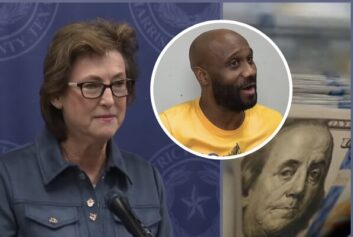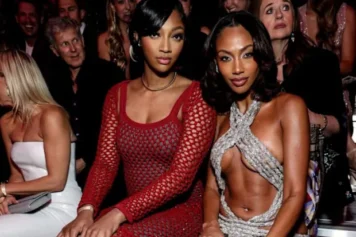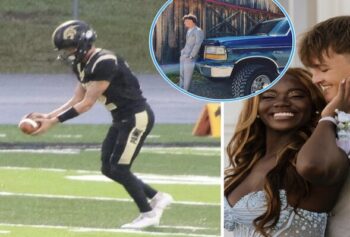(Main photo image credit: Facebook photo)
This is the second installment of our two part feature on the Spokane Hoopfest. For part 1 read here
Rachel Dolezal does not represent Spokane.
Not this past weekend.
Not ever.
There are no hate crimes here. There is unity and a coming together not divisiveness. No confusion as to identity, unless you consider those with little to no basketball skills playing hoops this weekend. Even then it does not matter. See, on the last weekend in June, it is simply about basketball.
Players of all ages and skill level travel to Spokane, Washington to play in the world’s largest 3-on-3 street basketball tournament: Spokane Hoopfest. They call themselves basketball players. Not because of the shoes they wear, or the jerseys/shirts on their backs or the name they call themselves. They prove it where it matters playing with heart.
In its 26th year, Hoopfest has welcomed players from 42 different states and multiple countries. Most of the players hail from the Pacific Northwest. Located in Eastern Washington, Spokane is less than a day’s drive from any area of Washington, Idaho, Oregon and parts of Western Canada.
Although the focus is on hoops, the variety of geographic locations close to Spokane brings in an eclectic mix of people. They come from all over, bringing their upper-, middle- and lower-class work ethics, cultures and beliefs. Basketball courts dot the downtown Spokane landscape with white, black and brown skin tones.
Sports, and in this case basketball, has a way of including all-comers. If you want to play at Hoopfest, you can play. Camraderie, team-work, sportsmanship and desire all take center stage. Skin color doesn’t matter. The goal is the same on both sides: to win.
(Photo credit: Pediment)
One of the people who also played in Hoopfest this past weekend was Gyasi Ross.
Ross has appeared on numerous television outlets as a prominent voice on Native American and the racial issues of our day. He is an author, speaker and activist who was raised on the Blackfeet Indian Reservation in Northwest Montana. He currently lives on the Suquamish Tribe’s reservation of Port Madison in Western Washington. His writings have appeared in the likes of Deadspin and Huffington Post.
Ross recently spoke with the The Shadow League on a wide array of topics, including the racial diversity present at Spokane Hoopfest, basketball in the Native American culture and Rachel Dolezal.
Where are you from? What tribe?
I’m from the Blackfeet Indian Reservation and my family is also Suquamish tribe. I live on the Suquamish Reservation currently (Western Washington). Right across the water from Seattle. Chief Seattle was actually the chief of the Seattle people. I am also from the Blackfeet Reservation, grew up there until high school.
How long have you been playing in Hoopfest? How did you first hear about it?
Off & on for about 10 years now. (I heard about it from) My little cousin, who I am playing with this year. I went to school on the East Coast. He told me he wanted to kidnap me for a weekend and bring me over here when I came back from school. And lo & behold, this was here.
What is it about Hoopfest that you think draws people of different cultures/races?
I think part of it is because there really is a place for everyone, culturally. For Native people like myself, personally, there’s a huge Native contingent here. It’s really cool to see that – people buying in. With Spokane, you’re always going to have a decent white population here. At some level, it really doesn’t matter. If you can play ball, you can play ball.
And that’s kind of the social Darwinistic beauty of Hoopfest 3-on-3 basketball. 3-on-3 basketball is just a brutal game. It’s really, really just caveman roots coming out. This year is particularly acute in that description because it’s HOT! Who cares what ethnicity you are. Who cares what race you are. It’s a very, very egalitarian thing. We’re all suffering together. All of my folks in South Dakota, North Dakota and Montana are going through Sun Dance right now. That’s an important thing. We suffer together. That brings out the humanity in people. And I think you see a lot of humanity in these conditions.
364 days a year, Spokane is so white. Did the cultural diversity surprise you how culturally diverse it has been? And, how have you seen it grow through the last 10 years?
I’ve seen it grow. Cultural diversity is sort of a red herring these days because everybody listens to hip-hop, right? I see folks with fair skin wanting to get Coppertone on and get brown skin I see cultural diversity. But when I see the influx of actual, physical human beings here of different ethnicities, yeah, that’s unique.
I think that’s something that benefits this city. It gives a level of humanity. Basketball and sports in general Jackie Robinson, Jesse Owens. Even Shoni Schimmel (read TSL’s two part feature on Schimmel here) present the humanity of a particular people. Because you can’t say when you see that person doing very well out there, you say, that person probably works just as hard as me. So all of these very, very malicious and insidious stereotypes of different ethnicities they’re lazy, they don’t like heat, they don’t like whatever they kind of go by the wayside when you see somebody that’s just really willing to work and is really good at their craft.
I think for places that are largely white like Spokane, or other places, when you see that influx of people of color, it really does have a humanizing effect. You realize that we’re just like everybody else, except for just a different hue.
In your ten years, have you seen any negative reaction while at Hoopfest?
I’m very sensitive to that. I was trained in that. I’m a lawyer by trade and I’ve done racial disparity work my whole life. I’ve never ever, ever, ever seen anything here. That’s amazing! Because there are so many people, there are so many businesses. But, I also believe these are business owners and they’re not stupid. Even if they have a bone in their body, and I’m not saying they do, I doubt they do. But, if they did, they realize that this is a huge economic boon to the area and to them personally, on an institutional level. I don’t think they would be stupid enough to bite the hand that feeds them.
It would have a huge, huge ripple impact if one of them were to get that reputation that they don’t like Natives or they don’t like black folks. Well, guess what that word is going to get out. Social media is an amazing thing.
I haven’t seen anything personally. In fact, I’ve seen the opposite. Our first year here, we had someone who was a business manager of a hotel, who probably flexed their muscles a little too hard. I don’t think it had anything to do with race. I think it had everything to do with her feeling overwhelmed by the moment. 275,000 people is a lot to feel overwhelmed by. But then, what I did see was her supervisor bend over backwards to accommodate and make sure that there were no feelings hurt either way. And I thought that was pretty impressive.
I would have no problem talking about it if I did see it. You’ve seen that. I’ve never seen anything here.
In my eyes, basketball is the top sport for the Native American community I even saw it down in Arizona. How important is basketball within the Native American community?
It’s huge. It’s hugely important. We come from places basketball for Native people and for impoverished people in general, because the vast majority of our communities still are impoverished. We come from rich places culturally, but impoverished on an economic level. Basketball is, within the United States, what soccer is to the world. You need a ball and a rim. When I was a kid, we’d use the spokes of a tire rim and use that as a hoop. Those places economically that can’t afford football equipment or can’t afford to sustain it baseball things that have a huge, huge initial spending fee (buy-in for the equipment to get the programs going) you can play basketball. For us, it’s very accessible.
Now, culturally as well, a lot of us come from places that, for whatever reason, are wide open spaces where there’s a lot of running. There’s a lot of opportunity for it. I come from a place where the elevation is about 4500 feet and we can run all day. Just evolutionarily, our lungs are huge. It makes sense that we would be good. In Arizona (where you talked about), in New Mexico, in Colorado, these places, evolutionarily we’re kind of built for it. It’s just a matter of getting the proper training. That’s sort of the punchline to it. You know, the question of why no Native American NBA players, because we live in remote places where those programs aren’t available; or the formalized training. It’s no accident any one of these players go to the NBA. It’s because they had access to the best trainers and the best AAU programs for a young age. As soon as we get that, we’ll be doing that as well because culturally it already has that importance to us.
I was watching Desert Horse Elite, a Native American team that won the 6-Foot & Under Men’s Elite last year. They won the 6-Foot & Under Men’s Championship last year. Does something like that have an impact on Native Americans to see that someone has achieved something granted it’s just Hoopfest?
Desert Horse is run by Zach Camel and JR Camel. They’re from Salish Kootenai the Confederate Tribe of Salish Kootenai. They have, like we just talked about, formalized programs in order to extract that talent. That’s the bigger significance. We have to see that success in these areas or academically or as an astronaut or whatever. It’s not the result of God smiling down and saying ‘you’re going to be good at this’. Instead, very specific practices that reach a particular outcome. And that’s what Desert Horse has done.
(Photo credit: KHQ.com)
The Salish Kootenai College (SKC) they have a program. Once again, you have those factors that we talked about. They’re about 3000 feet in the air so they can run forever. And when you add to that, rigorous training and discipline, you get good outcomes. We all have that capacity to do that within us. It’s just a matter of creating those programs and creating an infrastructure for that.
Rachel Dolezal
(Laughing) My girl. I’ve been looking for her. I wanted to take a selfie with her.
What was your reaction to that whole scenario? Not just how it made Spokane look, but what it said about or did it say anything about races in general?
Hell yeah! It wasn’t just about Spokane. It was about a particular type of cultural voyeurism that happens when people you know, Bell Hooks, one of my favorite scholars she has a concept called eating the other. That says when you want a piece of the primitive many people consider our culture whether you talk about African-American or Native American or Asian or Latino, it’s considered primitive, according to the civilizing hand of God. So, you want a piece of that, but without having to bear the consequences thereof. So it’s a thing of convenience.
I went to Evergreen State College and you had the white kids with the dreads who have the ability to (think) At the end, when I graduate, I can still cut my dreads off and reap the benefits of white privilege, but I had this time of flirting with the other, with the primitive. For people of color, we don’t have that option. We simply can’t do that. I can’t take off my brown skin. I can’t take off my flat nose. When I go into a store, I have the burdens that go along with that.
There’s a flirtation that goes along with that, that speaks very, very profoundly to white people’s centuries-old interest, curiosity with the other, with the primitive. Whether you’re talking about jazz music or hip-hop music or the Wild West Indian shows. Any of those things, we want them at arm’s length, but we don’t want to really understand, in depth, that culture.
Rachel Dolezal, she was somebody that by simply putting a weave in her hair and putting some tanning lotion on she could extract and internalize 300 years of victory through pain, through anguish and those learned experiences through genetic memory it doesn’t happen like that. Part of that is having the burden. You can’t have the benefit without the burden. That doesn’t simply happen with some tanning lotion and a perm.
It spoke very deeply about the status of what people fetishize our culture to be oftentimes that they are something that is easily accessible simply by checking off the boxes. I guess the reaction, and the reaction you saw from a lot people of color is that there is something deeper there. As mythological as race is, because I truly believe it is, but for people of color who have had to live with that burden it’s also something very real. So, the two run simultaneously.
Do you think that people confuse defining race and ethnicity? Society sees someone whose skin is brown and they automatically assume they’re Hispanic or Latino. Even the black Latinos, they are considered African-American when society simply looks at them.
Here’s the thing. W.E.B. DuBois talked about looking through double consciousness, seeing yourself through the eyes of the outside world. So we have to be cognizant of that. Raven Symone talks about the new black if somebody gets pulled over by the police, they’re going to treat you like the old black. That happens. That’s empirical fact. Those outcomes are based upon skin color, expectations of skin color. So internally, while it’s important to have that discerning effect that I fall within a particular tribe you’re my tribe. Not because of skin color but because of who we are (community).
But, at the same time it is important for survival purposes that I teach my 8-year-old son that he’s going to be huge like me. There are certain expectations that come with that. He’s going to have beautiful brown skin like me. And there’s going to be this expectation that he’s not intelligent or whether that he’s prone to violence or he’s going to drop out or be an alcoholic. Whatever those stereotypes might be those are going to be there. You can argue with the statistics, you can argue with the impressions, I don’t want those to be there. Whether or not you want them to be there, they’re there. So you have to be mindful of both of those expectaions, your own personally and also the exterior looking in.
Is there a cultural legacy to Hoopfest?
I don’t know yet. I was thinking about that the other day. I think there’s a lot of interracial babies made here. (Laughing) I definitely see that.
I don’t know yet. I’m not sure. I think that if there’s one, you would probably be more much qualified to answer that than me. I don’t see the residue – after the fact of whether or not there’s actually any choice made or effort made to understand the significance of basketball to certain communities. That it has been used as a survival mechanism. That there’s a reason, it’s not simply because people want to make interracial babies. But, there’s a reason why that so many people of color find this game so significant.
And, the white kids too. It’s not all about race. Part of that tribe as a basketball player is anybody who comes to play. Anybody who comes in good faith, respects the game, respect the parameters of the game so I don’t know consumerism/capitalism is an ugly thing. It’s usually simply concerned with the bottom line. It’s not necessarily concerned why the bottom line happens. Show me how to get there. My guess is the vast majority of these businesses, the infrastructure that’s already here and are still here when these beautiful folks leave, isn’t particularly concerned with the cultural component of it. And that, I think is a missed opportunity and that’s unfortunate. That’s my guess though. I don’t know that for a fact.





